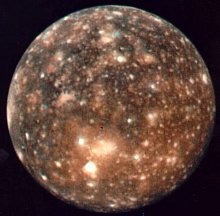CALLISTO'S PELLUCIDAR
There is, of course, not even a hint that Callisto is a hollow world.
So at this point, we’ve leaped into freefall without a net.
But, on the other hand, Lin Carter did follow Burroughs Pellucidar in
forging his own underground world, Zanthodon. For the record,
Zanthodon is an immense pocket approximately a hundred miles below the
north African sands, about the size of a small continent or large island,
inhabited by everything from Dinosaurs and Mammoths, to Cavemen, Minoans
and Barbary Pirates. Zanthodon isn’t quite Pellucidar, the
dimensions and directions don’t match, but in the Burroughs Universe, a
place like Zanthodon may be an outlier, a partially stabilized Hoos or
gateway.
And the thing is, that if Callisto really is in the Burroughs universe
with Barsoom, as we speculate, then its quite likely that it may be a hollow
world. After all, the Burroughs Universe contains two hollow
worlds in Earth/Pellucidar and The Moon/Va-Nah. One could be
a fluke. Two hollow worlds back to back suggests that this may be
a common formation. Elsewhere, I’ve speculated about the possible
nature of Barsoomian and Amtorian Pellucidars. So, allow me
to do the same thing here....
Assuming that there is such a thing, what would Thanator’s Pellucidar
be like? For starters, let’s call it Vanadar, as a tribute to Va-Nah
and Pellicidar.
Well, first, we can calculate its dimensions. Gravity for the
Moon/Vah-Nah, Earth/Pellucidar systems is the same on both sides.
When you are standing on Pellucidar, you don’t fall in towards the center,
any more than you fall out into space, standing on the outside. This
means that gravity is exerted from the shell itself in both directions,
inwards and outwards.
Now assuming that the composition of the shells is uniform from one
world to the next (which is a pretty big assumption, but we don’t have
much to go on), then the variation in gravity from one world to the next
comes from the different thickness of the shells. The
Moon’s shell is 250 miles thick, producing 16% gravity. Earth’s shell
is 500 to 800 miles thick, producing terrestrial gravity.
Thanators gravity is about 80% that of Earth’s, so proportionately,
its shell should be much thicker than the Moons, much closer to Earth’s.
Anywhere from 450 to 750 miles? We have to assume that Thanator’s
shell is much, much thicker than the Moon’s, so despite Thanator being
almost half again as large as the Moon, the internal sphere may actually
be smaller. The shell is probably close to the thickness of
Earth’s, definitely much greater than Earth’s proportionately.
Since it is a smaller world than Earth, the shell may actually be thicker
in real terms to make up for it.
Now, taking the diameter of Thanator, roughly 2770 miles, and subtracting
the thickness of the shell (on both sides) means that the inner sphere
of Vanadar is, very roughly, somewhere between 1870 miles and 1270 miles.
Both of these would be very rough guesses. Now with internal
diameters of between 1270 miles and 1870 miles, we can then calculate the
surface area of the inner Vanadar, somewhere between five million and ten
million square miles. This is compared to a surface area on
the topside of about twenty five million square miles.
In comparison, the internal surface areas of Pellucidar is about a hundred
and fifty million square miles, to two hundred on the surface. The
internal surface area of Vah Nah is eight million, compared to sixteen
million on the surface. The ratios in these cases being relatively
close, 3 to 4, and 1 to 2. Vanadar may be as extreme as 1 to 5.
Thanator has the most lopsided ratio of surface to interior, because
of its thick shell. And if we assume that the shell is towards the
thicker side, it has one of the smallest inner worlds we’ve yet seen, perhaps
as little as five million square miles, or midway between Australia and
South America, no larger than the Antarctic continent.
One consequence of this is that your inner world will have the most
pronounced curvature so far. If Pellucidar makes one feel as if you
are sitting in a great bowl, then inner Thanator may make you feel as if
you are at the bottom of a shot glass.
There are other consequences. With curvature that extreme, there’s
literally nowhere for rock to fold except straight up. Generally,
folding on the inside of a curve should produce higher extremes than on
the outside. All things being equal, Pellucidar’s mountains should
be taller than Earth’s (although if Pellucidar is composed of smaller and
faster moving plates, its mountains would be shorter and shorter lived).
Vah-Nah’s geography in the Moon Maid should be more extreme than the outside,
and if you read the Burroughs novel, there are suggestions that this is
true. If this is the case, then Vanadar likely is potentially
a land of savagely steep mountains, cliffs and chasms.
What
else can we determine?
We know that Earth has permanent Polar openings to Pellucidar, and it
appears that from time to time, other portals appear and disappear in Earth’s
surface offering entry to Pellucidar, leaving remnants or outposts like
Pal-Ul-Don, Caprona, Maple White Land and Skull Island. This is apparently
a slow but ongoing process on Earth, and is a factor of Earth’s live geography.
Essentially, slow ‘whirlpools’ form in the geological flows between inner
and outer worlds.
On the Moon, which was smaller and colder, geological death came faster.
The ‘whirlpools’ froze in place, leaving open holes, or Hoos, on the satellite.
Vanadar is likely unique. Like the Moon and Earth, it was probably
geologically active, with slow ‘whirlpools’ forming polar openings and
other holes. However, the greater thickness of its crust and its
extreme curvature suggests that it remained geologically live much longer
than the moon. Perhaps it is still geologically live.
However, the greater thickness from the moon, and greater curvature from
Earth probably made it much harder for Hoos or holes to form.
Indeed, Hoos might not form at all, and there may be no communication between
inner and outer worlds.
On the other hand, if they did form, its likely that the geological
processes would remain live long enough for them to close up, rather than
becoming frozen in place. Vanadar’s Hoos, if it had any, were probably
shorter lived than those on Earth, taking longer to form, and dissipating
more quickly, and probably being smaller. The polar openings, if
they formed, were probably much smaller and less stable than those on Earth.
That being said, perhaps we can extrapolate on the geography of the
interior, from considering the surface.
The major event for Vanadar, as with Thanator, were probably the twin
impacts close together which tilted the planet off its axis.
These impacts obviously didn’t punch through the moon. But if they
were intense enough that their shockwave traveled through Callisto and
produced the White Mountains on the opposite side, then I think we can
assume a similar shockwave impact on the inside.
Thus, Vanadar probably has an area of ferocious uplift, probably similar
to Tharsis on Mars. There are probably two titanic mountains
or volcanoes, sitting at the center of a complex of volcanoes, Extreme
Cliffs, towering mountain ranges, and ferocious chasms radiating outward
from the impacts like entangled spider webs. The force of the
impact would have sent boulders and mountains flying like a shotgun blast,
peppering a large part of the interior with debris. In short, nasty
disordered territory.
Opposite, there would be another jumbled complex of mountains and cliffs.
This secondary complex would lack the signature twin supermountains, and
the explosive burst of debris. It would be more jumbled and disorderly
The impacts shifted Thanator off its axis, causing its old poles to
drift and new poles to orient. The result topside was two seas, the
Corund Laj and Sanmur Laj, whose shapes are distorted by the stresses of
the worlds revolution. If there were polar openings, the sites
of Corund Laj and Sanmur Laj were probably it. These polar
openings would have been smaller, and its possible that they closed naturally,
or that their relocation closed them. But it is likely that there
is still some connection here between inner and outer worlds, and an intrepid
Thanator submariner might well make it into Vanadar.
The Corund and Sanmar Laj seas are probably the melted remains of polar
caps, so if there was a connection, or if there still is, then those areas
would contain two of Vanadars three small seas. These seas
would be the inner growths of polar glaciation melted to liquid water.
The twisting and distortion that we saw topside is probably more extreme
here in the underworld where curvature piles rock on top of itself.
The shapes of the interior seas are probably those of distorted spiral
starfish or octopus with long tendrils reaching out, surrounded by savage
lines of cliffs and mountains, even more extreme and tortured than those
found surrounding the surface seas.
And the third sea? Well, Vanadar is tidal locked, always presenting
the same face to Jupiter. On the surface, tidal moisture is drawn
to the front of the planet, closest to Jupiter, supplying the Grand Kumala
rain forest with its water. On the interior, water will
be drawn the same way, so directly opposite the Grand Kumala on the underside
closest to Jupiter, you’ll find a small sea. Or perhaps not so small.
While the former polar seas are probably slowly emptying and losing their
inherited waters, the central sea, encouraged by Jupiter’s gravitational
tidal tug is probably slowly growing.
It is not clear whether there are openings at the site of the new poles.
It appears though that one pole is frozen over, the other is not.
We have no explanation externally why one pole should be different from
the other. Perhaps the explanation lies internally, in which
case, we can assume that there is one new opening at one of the poles.
Despite all this talk of seas, Vanadar is probably a comparatively waterless
place. Earth’s and other planets water comes from comets.
Obviously, very few comets strike the inside of a world. Rather,
water reaches the interior world through atmosphere exchange with the exterior.
Thus, the interior is always dryer. We see this with Pellucidar,
where despite constant Hoos and permanent polar openings only 1/3 to 1/2
of Pellucidar’s surface is covered by water. For the Moon,
the surface is dead and dry, its waters long lost to space, but the interior
waters are preserved, and amount to only three small seas.
We know that on Thanator, there are only two seas, a large lake and the
polar cap which constitute its water. Perhaps 20% of the world’s
surface. So, perhaps at best, only 10 or 15% of Vanadar is
water covered (though it may actually be more, given the really lopsided
ratios of inner and outer surfaces).
So, what’s it like on the interior. I’m thinking pretty
nasty. We know that both Va-Nah and Pellucidar have inner ‘stars’,
most likely dwarf black holes which the planet forms around like a shell.
Its likely that in the Burroughs universe, this is the mechanism for the
formation of small worlds like Earth and the Moon. So if Vanadar
exists, then it probably has such a ‘star.’
What’s Vanadar’s star like? Pellucidar’s burns perpetually
radiating light and heat. Vah-Nah’s star is invisible, producing
gravity, perhaps radiating heat, but not light. Vanadar’s star
is likely more similar to Pellucidars, it’s potentially a bright, warm
body. As to how much heat or light it might radiate, and what sort,
its hard for me to guess
But there’s another special factor to Vanadar’s star. The thing
is a magnetic powerhouse. It radiates a magnetic field powerful enough
to light up the outer atmosphere like a neon lamp, and help to provide
heat as well. What does this mean for the star of Vanadar?
Well, Earth’s ‘star of Pellucidar’ generates a powerful magnetic field,
though not nearly as powerful as this Vanadars. It’s not clear what sort
of magnetic field Vah-Nah’s star generates. But on a guess, I’d say
that strong magnetic fields may be related to strong light output, perhaps
light in the higher ranges up to ultraviolet.
What does it mean for the interior? Well, it suggests that Vanadar
is extremely hot and bright, both for the star’s output and for the side
effects of its magnetic field. Perhaps significantly hotter and brighter
than the surface. Indeed, it may be so hot and bright as to
be uninhabitable, a scorched wasteland whose inhabitants cower in eternal
shadows.
The magnetic output may make things interesting in other ways.
The intense magnetic output may have electrical effects. Think
of mountains constantly discharging lighting at each other and at the sky
like those static generator balls. Think of a floating electrical
potential so that as you walk around, you begin to accumulate your own
St. Elmo’s fire glow.
A hotter more volatile interior world may see much more moisture being
perpetually liberated into the atmosphere. After all, extremely
hot conditions from the ‘star’ radiation and magnetic side effects may
literally boil water. A lot of the interior’s water may be up in
the atmosphere and Vanadar may have a very intense hydrological cycle.
Atmospheric water rises and forms clouds which blot out the sun, causing
thermal differentials. The mountains constantly channel the clouds
around, and perpetual flash flood torrents roar down mountain channels.
Throw in ferocious winds and you’ve got an interesting forbidding and
strange land. Changeless land of extreme contrasts, an ever burning
sun, sheer cliffs, perpetual lightning and ferocious sudden rain storms.
What sort of things live there? I wouldn’t venture to speculate,
let someone else populate it with plants and animals if they’re so minded.
I do offer one thought...
On the surface of Thanator, we know that the Mind Wizards are alien,
and that the humans are likely just as alien. The winged cannibals
and amphibians have their counterparts on other worlds, and hence probably
do not originate on Thanator.
But the insectoid Yathoon have no obvious counterparts anywhere else
in Burroughs or Kline. There is no sign of an ecology or flowering
of insectoid evolutionary lines which would have produced something like
the Yathoon or Wells’ creatrues on either Thanator or the Moon, or for
that matter, on any other world described by Burroughs or his contemporaries.
So, here’s a thought. Perhaps the Yathoon are the original ruling
race of strange Vanadar, a tribe of whom has made it to the surface.
This certainly would explain the anomaly of their presence. Vanadar,
in this case, would be a strange primeval wilderness of giant insects of
every sort. Imagine beetles and mantises the size of elephants and
allosaurs, and a hundred other forms, each more exotic than the last.
Is there anything that might support this notion? Well, it seems
that the hidden valley of Sargol, which is the centre of the Yathoon’s
race and culture is right smack in the middle of the Black mountains, surrounded
by a river of lava, and heated in what may be a uniquely geologically live
area. In short, it fits the characteristics you might look
for, for a temporary Hoos which offered passage between inner and outer
worlds to a wandering Yathoon population. Food for thought.
And with that, ladies and gentlemen, I’ll leave you pondering...








